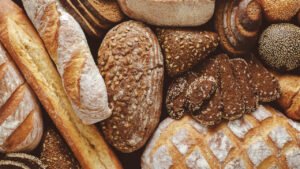Flour is an essential ingredient in the kitchen available in various types, each designed for different baking needs. However, who among us hasn’t wondered about all these types of flour? We all realize that there is much more than just regular all-purpose flour, especially when faced with rows of bags in the baking aisle that can leave us scratching our heads. What should we select for making baguette, rich dough, pastries, and other baked goods?
Don’t panic! In this guide, you’ll explore the 12 most common types of flour, from bread flour to whole wheat flour and beyond. You’ll learn what is made, the best ways to store it, what kinds of flour professional bakers use, and the key difference between bleached and unbleached flour. Read on to find out which is the ideal flour for your next recipe.

What is Flour Made From?
Flour is finely milled powder derived from grains, nuts, beans or seeds. It is the most important ingredient in baking as it gives baked goods their texture, structure, and flavor. The composition of flour varies depending on its source, but most contain a combination of starch, protein, nutrients, and flavor compounds, all of which affect the texture and taste of the final product.
Wheat flour is the most common flour and is available in different varieties depending on the wheat strain and milling technique. All types of wheat flour have a high gluten content, which is essential for developing the texture, structure of baked goods. In contrast, whole grain flours such as rye and barley offer a nuttier flavor, a coarser texture, and additional nutritional benefits.
What’s the Difference Between Bleached and Unbleached Flour?
Bleached flour undergoes chemical treatment with agents like benzoyl peroxide or chlorine dioxide to speed up the aging process by breaking down proteins and starches. This treatment yields a very tiny grain with a very soft texture and a lighter color, ideal for producing lighter, fluffier baked goods with a finer texture.
Unbleached flour, on the other hand, is naturally aged after milling by exposing it to air without the use of any chemicals. This natural process results in slightly larger grain with a denser texture and a pale yellow color that is better suited for yeast-based baking.
What Types of Flour do Professional Bakers use?
Professional bakers use specific types of flour for baking that are rarely used by home bakers to produce superior baked goods, each selected for its specific properties and the desired type of bread or pastry being made. Sometimes, bakers also blend different kinds of flour to create some signature breads, such as in this wheat bran bread recipe.
The protein content of flour is the most important factor that bakers rely on when choosing the right type of flour for each recipe. The higher the protein content, the better the ability of the flour to absorb liquids, making these flours useful in recipes that need more chewiness, structure, and volume or when making enriched dough. Conversely, the lower the protein content, the softer, more crumbly, and less chewy the texture becomes, making low-protein flours such as pastry and cake flour more suitable for recipes such as quick breads, cakes, and desserts.
Different Types of Flour: Uses, Flavors & Texture
All-Purpose Flour

A blend of hard and soft wheat flour with moderate protein levels (10-12%), used in a wide range of baked goods, making it the most versatile flour on this list. All-purpose flour works well in most uses and gives excellent results in various baking recipes, such as cakes, cookies, biscuits, pizzas, bread, and more. However, using bleached or unbleached all-purpose flours can produce different results. Unbleached flour tends to produce a denser texture, chewier results, and are better suited for baked goods that need structure such as yeast breads. In contrast, bleached flour produces lighter baked goods, making it ideal for making quick bread, biscuits, and pies.
- All-purpose flour uses: All baked goods and food.
- All-purpose flavor and texture: Neutral flavor and fine, powdery texture. But they may differ based on their bleached or unbleached nature.
Pro Tip: Mix 8 tablespoons all-purpose flour with 2 tablespoons cornstarch to make cake flour.
Bread Flour
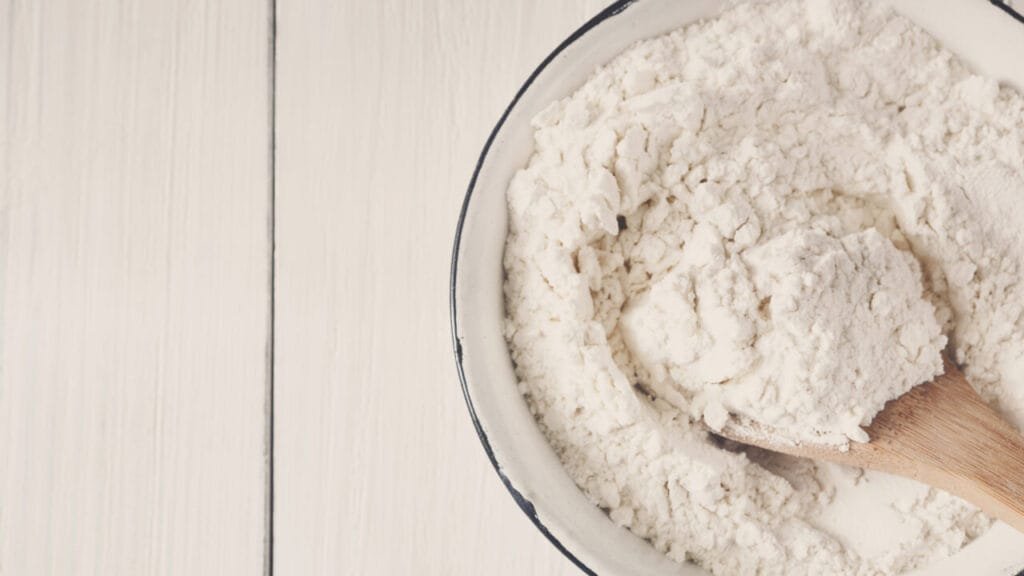
As the name suggests, bread flour is a type of flour made of milled hard wheat grains specially designed for making bread. Its high protein content (12%-16%) leads to a higher gluten content in the dough compared to other flours, resulting in an airy, chewy texture and a more open crumb. Although bread flour can be replaced by all-purpose flour in certain recipes, bread flour works better in pizzas, yeasted and sourdough breads, enriched doughs, and bagels. To find out more in-depth information about bread flour, consider learning What is bread flour?
- Bread flour uses: All types of bread, rolls, pizza dough, enriched dough recipes.
- Bread flour flavor and texture: Neutral flavor and hard texture.
Whole Wheat Flour

Unlike other types of wheat flour, whole wheat flour is made from the entire wheat kernel (germ, endosperm, and bran). Because of their high fiber, mineral, and vitamin content, these extra parts enhance the health benefits of baked goods. Compared to white flours, whole wheat flour produces a dense texture and a hearty flavor. That’s why professional bakers often combine it with a small amount of bread or all-purpose flour to balance its flavor and texture and achieve the desired crumb structure. Notably, white whole wheat flour, milled from durum white wheat, is the most commonly used as it provides a milder flavor and lighter appearance while still retaining the nutritional benefits of whole grain flour.
- Whole wheat flour uses: All baked goods and food.
- Whole wheat flour flavor and texture: Hard texture with nutty and earthy flavor.
Pastry Flour
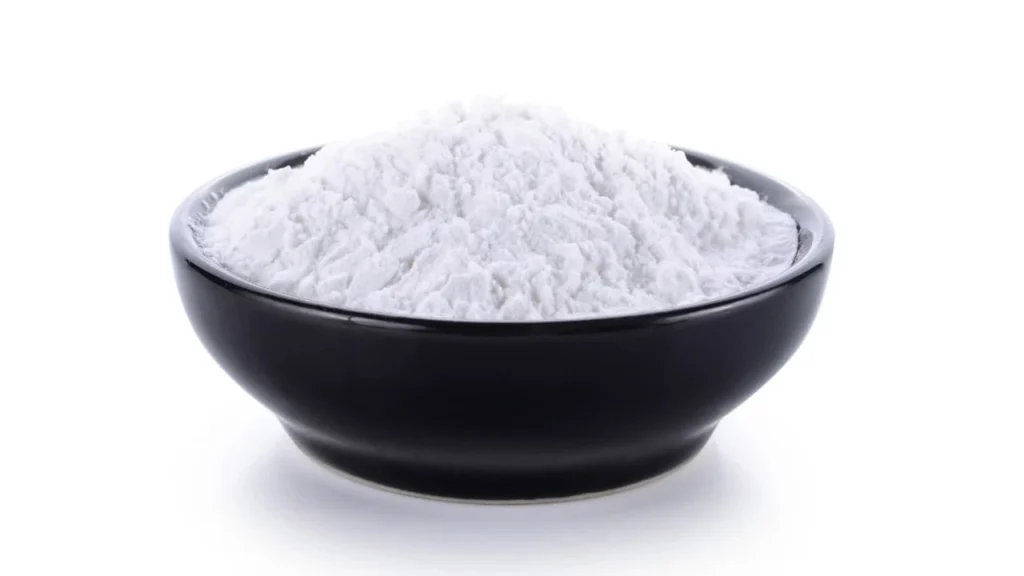
Nestled between cake flour and all-purpose flour, pastry flour offers a balanced protein content (8-9%). This low level of protein minimizes gluten development when mixed, resulting in tender crumb and flaky texture instead of chewy texture—ideal for tender, flaky pastry recipes such as tarts, pies, baklava, and homemade croissants. No pastry flour on hand? Simply mix 1/2 cup of all-purpose flour with ½ cup of cake flour to create an easy substitute.
- Pastry flour uses: All pastry doughs and batters, including cakes, muffins, baklava, and cookies.
- Pastry flour flavor and texture: Neutral flavor with fine, deep white powdery flour.
Pro Tip: Combine ½ cup all-purpose flour with ½ cup cake flour to make homemade pastry flour.
Semolina Flour
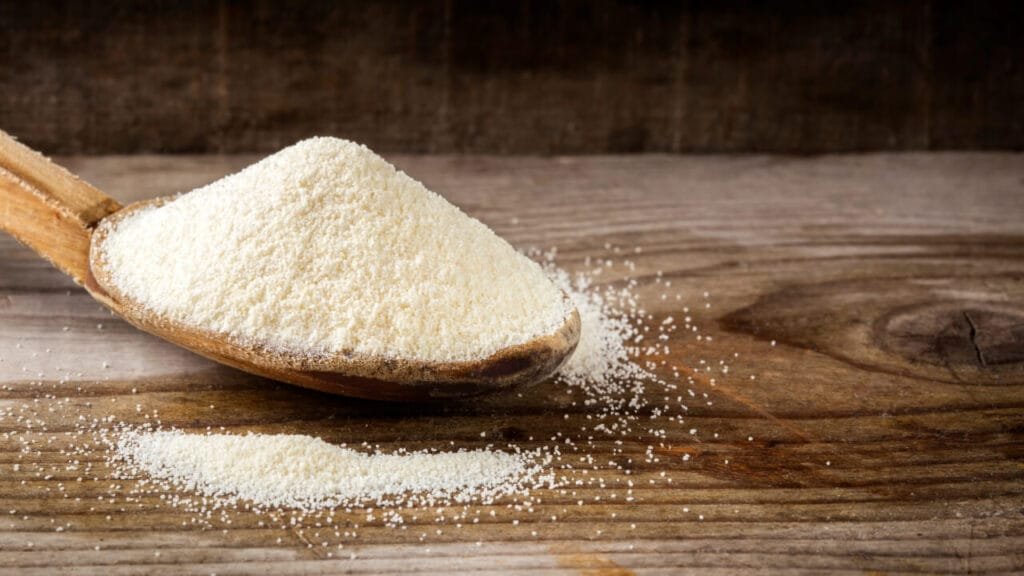
Golden-yellow flour milled from durum wheat, a type of hard wheat variety known for its high protein content and rustic flavor. While it’s most famous for making pasta and couscous, semolina flour is also commonly used in North African and Italian breads, such as ciabatta and pizza dough. Semolina flour comes in three different textures—coarse, fine and very fine—each suited to different baking and cooking needs.
- Semolina flour uses: Bread, couscous, pies, pasta, and pizza doughs.
- Semolina flour flavor and texture: Nutty, slightly sweet flavor, and varying textures depending on the type of semolina flour.
Barley Flour
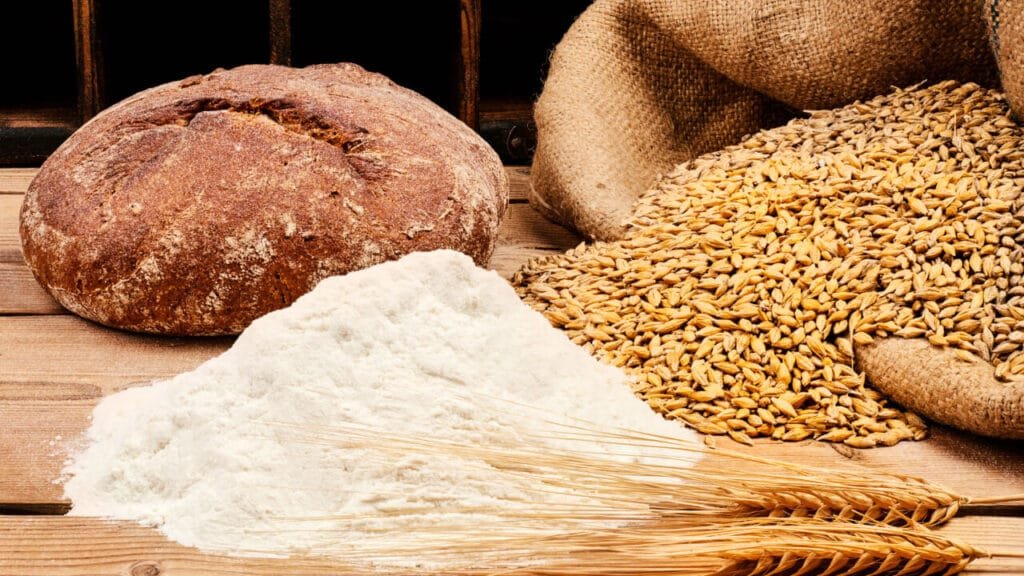
Known as one of the healthiest types of flour, it comes in three different varieties, including hulled barley flour, pearl barley flour, and whole barley flour. Hulled barley flour retains only the nutritious bran layer while removing the tough, inedible outer hull. Pearl barley flour is made from milled pearl barley from which the outer hull and bran layers have been removed, resulting in a smoother texture and lighter flavor, and is mainly used in soups, stews, and casseroles. Whole barley flour is made by milling the whole grain, including the hull, bran, germ, and endosperm, making it rich in nutrients and fiber.
- Barley flour uses: bread, muffins, soups, stews, and casseroles.
- Barley flour flavor and texture: Sweet with a nutty flavor and can be found coarse and fine.
Rye Flour

Ground from the rye kernel, a member of the wheat family that is closely related to the barley grain. Compared to wheat flour, rye flour contains less gluten and has a nutty, earthy, light malty flavor. Rye flour come in four flour varieties, each offering unique characteristics: White rye flour, made only from the starchy endosperm, is best used for creating light, airy loaves; Medium rye flour includes some rye bran, giving it a darker color and a more robust flavor, making it ideal for tarts and delicate doughs; Dark rye flour, made from the entire rye kernel and has a deep, earthy, and slightly sour taste; Pumpernickel flour, coarser than white and medium rye flour, is best suited for hearty baked goods like pumpernickel bread.
- Rye flour uses: Bread, cookies, pies, and pancakes.
- Rye flour flavor and texture: Dark and soft flour with nutty, earthy, light malty flavor.
Gluten-Free Flour Blends

Especially made for people with celiac disease, gluten intolerance, or dietary preferences, gluten-free flour is a versatile alternative to traditional wheat flour. It is made from a variety of grains, nuts, seeds, and starches, such as rice, almonds, coconut, tapioca, and sorghum. This flour often includes binding agents such as xanthan gum or psyllium husk to hold the batter or dough together as on this homemade gluten-free bread. While gluten-free flour blends are common, individual gluten-free flours such as almond flour, coconut flour, rice flour, and oat flour are also widely used in baking.
- Gluten-free flour blends uses: All baked goods and food.
- Gluten-free flour blend flavor and texture: Flavor and texture may vary depending on the composition.
Self-rising Flour

A type of flour that already contains a leavening agent (baking powder) and salt with 8-9% protein content. It’s specifically designed as a substitute for recipes that call for all-purpose flour without the need for a leavening agent. Although it can be used in most baking recipes, such as cookies, cakes, quick breads, pies, etc, self-rising flour cannot be used in recipes that call for yeast.
- Self-rising flour uses: Quick bread, cookies, cakes, and pies.
- Self-rising flour blend flavor and texture: Silky texture with a flavor similar to all-purpose flour.
Pro Tip: Combine 1 cup all-purpose flour, 1 ½ teaspoons baking powder, and ¼ teaspoon table salt to make homemade self rising flour.
Corn Flour

Although cornstarch and cornmeal are both made from corn kernels, they are used for different culinary purposes due to their different production methods and compositions. Cornstarch is made by extracting only the starch from the endosperm of the corn kernel and is primarily used as a thickening agent. Corn flour, on the other hand, is produced by grinding whole dried corn kernels into a fine, smooth texture. This gluten-free flour comes in two varieties: white corn flour made from white corn and yellow corn flour made from yellow corn kernels. Both types are commonly used in baking, especially in cornbread, tortillas, and muffins, contributing a slightly sweet and earthy flavor.
- Corn flour uses: Tortillas, cornbread, muffins, cake, and pancakes.
- Corn flour flour flavor and texture: Fine, smooth texture with nutty, sweet flavor.
Spelt Flour

Made from an ancient variety of wheat, also known as dinkel wheat. One of the distinctive characteristics of spelt is that it has a slightly higher protein content than other flour varieties and has an earthy, nutty flavor that adds depth to baked goods. When used, spelt flour gives you the option of substituting wheat flour in ratios ranging from 1:4 to 1:1.
- Spelt flour uses: All baked goods.
- Spelt flour flavor and texture: Soft texture with mild flavor.
buckwheat Flour

Contrary to what the name suggests, buckwheat flour is not made from wheat but is made by grinding buckwheat groats—the hulled seeds of the buckwheat plant. Buckwheat flour is naturally gluten-free and has a distinctive, earthy, and slightly nutty flavor, making it popular among people with gluten sensitivities, as it can be used in a variety of recipes, including bread, crepes, pancakes, etc.
- Buckwheat flour uses: Bread, pancakes, crepes, and cookies.
- Buckwheat flour flavor and texture: Earthy, grassy flavor with a slight bitterness and a milled to finely powdered texture.
How to Store Flour Properly?
The paper bags that flour comes in are made of a breathable material that allows the moisture left over from the milling process to evaporate, which is great for recycling as mentioned in the King Arthur article, but does not protect against things like moisture and heat, which can encourage flour spoilage. So, once you have any kind of flour, keep it in an airtight container in a cool, dry place like a pantry to keep it fresh and prevent spoilage.
Not all flours are created equal, so not all flours have the same shelf life. For instance, white flour can last between 6 to 12 months and can last up to one year in the refrigerator and two years if frozen, while whole grain and nut flours have a shorter shelf life than white flour and can only be used for about 6 months.


